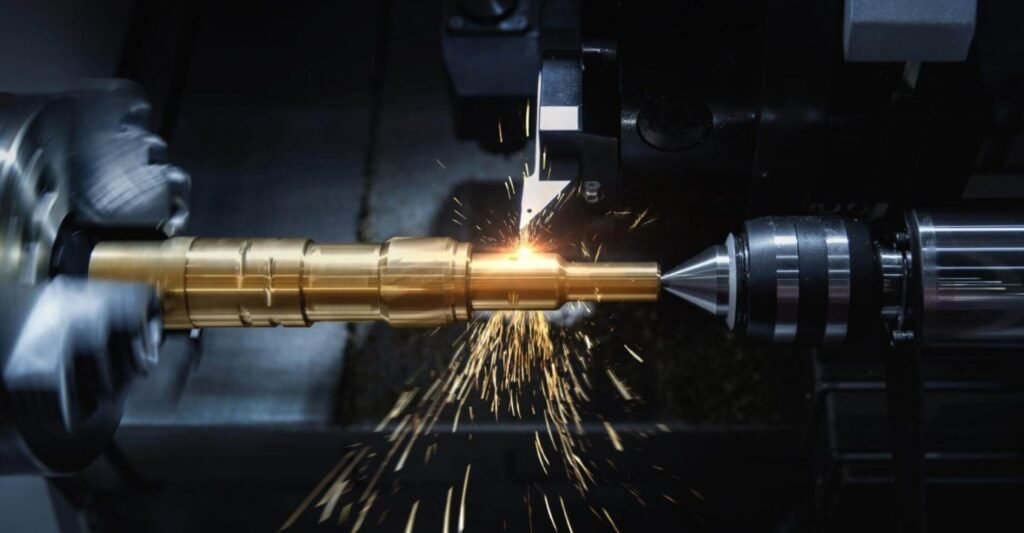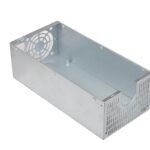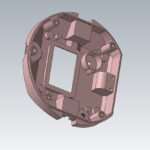Introduction
Aluminum is the second most prevalent metal, after iron, to be processed in all kinds of manufacturing industries. Due to its high machinability and strength, aluminum is widely CNC machined to make thousands of different types of products. From lighting fixtures to spaceships and aircraft, aluminum alloys are used in almost every industry.
Aluminum offers many benefits in CNC machining. This article will discuss the properties that make it unique, applications, aluminum alloys best for CNC machining, and the advantages and disadvantages of using aluminum in CNC machining.
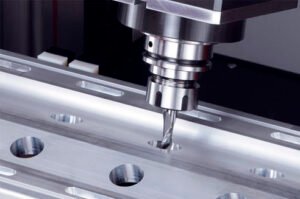
Characteristics of Aluminum
Pure aluminum is silvery-white in appearance, non-magnetic and ductile metal. It is mainly alloyed with other metals such as copper, manganese, and magnesium to enhance the corrosion resistance, strength, and other properties that are required in machining.
Abundantly found in the earth, it is the second most prevalent metal in the manufacturing industry. Due to its recyclability, aluminum saves almost 95% of the energy and forms a big part of our world’s infrastructure.
Aluminum’s non-toxicity opens doors for its use in medical applications and food packaging and storing. May it be kitchen foil, food cans, or utensils, aluminum poses no harm to the end consumers.
Low density, great malleability, and high thermal conductance make it suitable for transmission lines. It’s better than copper in many ways, such as being cheaper and offering better electric conductivity.
You will find aluminum in your cola cans, household appliances, windows, furniture, cars, building structures, medical devices, airplanes, spacecraft components, trains, ships, and much more.
Figure 1 Courtesy: Statista.com
Comparison with Steels
Steel and aluminum have the biggest share in the manufacturing sector. While steel is known for its excellent strength, malleability, ductility, and corrosion resistance, aluminum comes on par with it due to its high strength-to-weight ratio.
Although aluminum has high corrosion resistance due to its ability to form a protective oxide layer on top, it still cannot beat the corrosion resistance offered by chromium in stainless steel. Moreover, aluminum has quite a low melting point of 600°C compared to steel ~2500°C.
Many alloys are formed by just a slight alteration in the compositions of the added metals in aluminum. We will discuss alloys of aluminum later in this article.
Steel takes the lead because of its economic viability. One pound of steel is cheaper than a pound of aluminum. However, currently, both metals are extensively utilized in their respective industries.
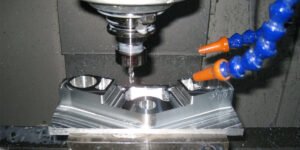
Advantages of using Aluminum for CNC Machining
Aluminum is a lightweight material with a solid strength to mass ratio. This characteristic is already enough reason for most parts to be manufactured using aluminum. But when speaking about CNC machining, aluminum provides many extra perks in manufacturing. Like easier workability, faster machine times, and better finishing.
Following are a few advantages of aluminum concerning CNC machines.
Rapid Prototyping
Rapid prototyping is the practice of fabricating parts, models, or samples quickly using CAD. Aluminum is a softer metal and can be machined swiftly. CNC machines further increase the efficiency of this process.
Prototyping is a multi-step process, with a single prototype will undergo lots of small changes. Each change comes with a new iteration of the prototype. And the time spent machining every new iteration will add up. Time is money, and time wasted can drastically hinder the development of a product.
Since time is an essential factor for prototyping, aluminum is the preferred material for such endeavors.
Recyclability
Aluminum is insanely cost-effective when recycled. CNC machines can quickly remove a lot of material from a block of aluminum. But that removed material is now in the form of chips and shavings, essentially useless. Recycling these chips can help reduce the cost.
Recycling aluminum is a highly efficient process. It requires way less energy to recycle compared to other metals. Aluminum’s ability to avoid rusting allows chips from CNC machines to be stored without fear of corrosion.
Corrosion Resistance
Corrosion comes in various forms; the most common one is rust. Iron and steel are notorious when it comes to rust; even small amounts of moisture can cause corrosion. But aluminum doesn’t have this issue. Because aluminum reacts with oxygen to form an aluminum oxide on its surface, this thin layer acts as natural protection from all manner of corrosion.
It’s a common practice to manufacture complex parts using CNC machines. The parts often have crevices or cavities that are corrosion-prone.
For Steel parts, it is necessary to coat them with corrosion-resistant finishes. Upon failure to do so, rust sets in these crevices. And it becomes extremely time-consuming to remove rust from said crevices. Corrosion like this is, of course, not a concern when dealing with aluminum.
Strength to Weight Ratio
Aluminum is famous for its incredible strength and low weight. This particular property is the reason behind aluminum’s widespread use in manufacturing. A high strength-to-weight ratio means you can manufacture the same strength parts but using less material.
This lightweight property not only helps you reduce the cost of manufacturing because the less raw material is required. But it also reduces shipping costs because of the lower weight.
The aerospace industry especially loves lightweight materials. Modern rockets require thin aluminum shells to reduce weight. Unfortunately, at that thinness, aluminum loses most of its strength. This is where CNC machined aluminum plays an important role.
Thin support structures are machined directly into the aluminum slabs. These support structures vary from design to design. But they compensate for the thinness by providing additional reinforcement. This is a delicate and precise process that can only be done using CNC machines.
Alloy Versatility
There is an extensive range of aluminum alloys available for CNC machining. Aluminum alloys can significantly boost the base specifications of pure alloy.
Pure aluminum is very soft and has a tensile strength of only 90 MPa. This property can be increased up to 600 MPa for certain aluminum alloys.
Some aluminum alloys are heat treatable, like 2000, 6000 & 7000 series. And others like 1000, 3000, & 5000 series are non-heat-treatable. Only the 4000 series of aluminum alloys contain heat treatable and non-heat-treatable alloys.
Though all of these alloys are CNC machinable, it’s best to select the suitable alloy according to desired properties carefully.
Disadvantages of using Aluminum for CNC Machining
Aluminum has a lot more benefits than drawbacks. However, all factors should be considered when selecting the suitable material for machining. The few shortcomings of aluminum can render it useless in specific applications.
Following are two significant drawbacks when CNC machining aluminum.
Thermal Properties
Aluminum has a lower melting point than steel and twice the thermal expansion coefficient. Both these properties reduce the operating temperature range for parts made from aluminum.
Poor Thermal properties can negatively affect the CNC machining of aluminum. The low melting point causes the fusion of material due to friction.
Alloy Confusion
The sheer number of aluminum alloys can confuse a novice operator. Understanding aluminum alloys is a necessity for CNC machining. Alloy often increases one characteristic while decreasing another.
For example, Aluminum 7075-T6 has high tensile properties but sacrifices ductility and corrosion resistance.
What Aluminum Alloys can be CNC Machined?
Aluminum has a wide range of alloys, with varying properties. Nonetheless, these alloys are still aluminum. A softer metal with a low melting point. Therefore, theoretically, all alloys of aluminum are CNC machinable.
Some alloys may require a harder tool to cut than others. All aluminum alloys have pretty much the same modulus of elasticity. But their tensile strength will vary drastically. And for CNC machining, the more relevant property is hardness.
Hardness is a material property to resist local deformation. Deformation such as scratches or indentation. Harder materials require harder tools to cut. So, aluminum alloys with increased hardness will be more difficult for CNC machines.
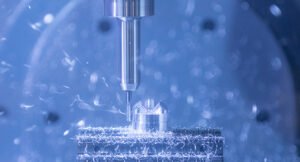
What are Aluminum Grades?
Aluminum alloys are categorized by their additives. Magnesium, copper, and silicone are the three most commonly used materials in aluminum alloys. The names of alloys do not represent the percentage of portions of these materials.
The name conventions are set by organizations; different organizations will have different prefixes but the same number. The sole exception is the ISO standard, which uses chemical notations.
For example, Aluminum 6061 is labeled as,
[Aluminum 6061 naming standards]
Aluminum Alloy designation system
Aluminum alloys are designated as 4-digit series ranging from 1000 to 8000. The first digit represents the primary constituent of the alloy. The second digit is for the modification to the series. And the last two are for placement of the alloy in the series.
For Example, Aluminum 2195, “2” represents the 2000 series, which is copper-based. The “1” shows this is the first modification on the 2095 alloy. The “95” here is a unique identification in the series
As such Aluminum 2004 and 3004 have no similarities despite the common 04 in the name.
[Aluminum Alloy Series Table]
Aluminum alloys also have a suffix at the end to designate post-processing. The “H” suffix is for designating the strain hardening and the “T” suffix is for designating Thermal Treatment.
[Aluminum Alloy Suffix Table]
For example, Aluminum 6061-T6 is magnesium and silicon alloyed aluminum that has been heat-treated and aged.
Table-Comparison of Different Al Alloys
Following are a few commonly used aluminum alloys for CNC machining.
[ALUMINUM ALLOY CNC TABLE]
It’s best to use the alloy most suited for your application. Aluminum alloys can be expensive, especially for higher strength variants. The most commonly used alloys for CNC machining are the 2000 and 3000 series alloys. With the 6000 series being only used for high-performance applications.
It’s best to double-check the compatibility of your CNC machine with the desired alloy.
Post -Processing of Aluminum after CNC
Post-processing of machined jobs includes finishing, treating, painting, polishing, etc. They are many such processes that are done according to specific requirements of clients.
Post-processing of Aluminum products is used to further enhance the products and improve their market value. Here we have jotted down some popular Aluminum post-processing treatment methods:
Aluminum Oxidation
The oxidation process is done to strengthen the aluminum. This increases the resistance to wear of the Aluminum product. Oxidation process is done by an ionic chemical reaction on the surface of aluminum with oxygen in the air.
Aluminum Finishing
Surface finishing of the aluminum product is done to remove debris, sharp edges, and overall aesthetics of the product. There are multiple types of the finishing process.
Machined
This is done by grinding the aluminum job with a high-speed rotary disc. Sharp-edged is removed, and strict tolerance is met.
Powder Coating
Aluminum products are primed by phosphate/chrome coating, which enhances their corrosion resistance. Now the parts are powder coated by an electrostatic sprayer. The finished product is baked in an oven at 200℃. Powder coating gives the final product a unique shine, smooth surface, and enhanced durability.
This coating also gives a unique protective layer that saves aluminum from rust. You may want to increase the thickness up to 72um for an extra finish. However, it decreases the dimensional control of the product.
Anodizing
Anodizing- an electrochemical process that increases the thickness of a part’s natural oxidation layer. This new thicker and more dense layer increases durability, electric non-conductivity, and corrosion resistance.
Keep in mind anodizing can only be done on good conductors like titanium and aluminum alloys. It involved submerging the part in a sulphuric acid bath. The aluminum part act as an anode, and the cathode is present on the other side. The movement of ionic charge happens when an electric current is passed through, and the deposition of oxidation layers starts to happen.
Anodizing process gives the most aesthetically elegant finish to the product, but it is expensive compared to other processes.
Bead Blasting
Bead blasting is typically done to apply a matte or silky finish to the aluminum part. As the name suggests, millions of glass beads are blasted through a pressurized gun onto the part. It creates a consistent granular finish.
Remember, it does not enhance any physical material properties of the aluminum product. Everything is purely visual. Bead size and grade are also important factors to consider.
Aluminum Paint
Aluminum products are either painted with liquid paints or a spray gun. This adds resistance to corrosion and rust. It also makes the product visually appealing.
Aluminum Polishing
Polishing is done to further refine the surface of the product. It is similar to aluminum finishing, but it goes even further to put a protective layer of corrosion-resistant material over the surface. Extra shine that it produces increases the visual appeal.
Aluminum Conditioning
Aluminum conditioning is the process done prior to electroplating processes like anodizing, used to eliminate any impurities from the metal, which may cause hindrance in further processes. Impurity is just a fancy word for dust and sand etc. Use alcohol pads to clean it effectively.
Best Aluminum Alloy for CNC Machining
Aluminum Alloy 6061-T6 is our pick for the best aluminum alloy for CNC machining. Why is that so? Because its most popular alloy in the market, easily available at the best prices. It’s versatile and has suitable material characteristics for product manufacturing. 6061-T6 has a good weight to strength ratio and is best for use in low to moderate stress applications.
Conclusion/Call to Action
Now you know how aluminum plays a vital role in revolutionizing the manufacturing industry. Many fields like Aerospace and Automotive transitioned further due to the fantastic properties of aluminum. We have covered all the aspects related to aluminum and its alloys. There is no doubt aluminum alloys are remarkable for CNC Machining.
Here at QBH Technology, we provide vast CNC services for aluminum alloys. Our high-tech machinery delivers high-quality products in short lead times. Want a custom part? Don’t know where to start? No worries, we are here to guide you at all stages. Our list of services includes CNC machining (lathe, mills, etc.), high-quality welding, precise laser cutting, and much more. All at competitive market prices.
So, Contact US NOW!

